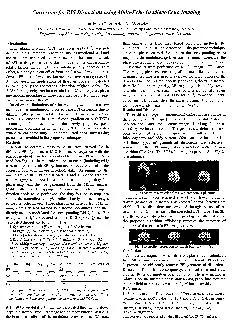

Nankuei Chen Alice M Wynvicz Centerfor MR Research ENHResearch Institute IO33 University Place ISO Evanston IL 60201 Departments of Biomedical Engineering Neurobiology and Physiology Nor ID: 836254
Download Pdf The PPT/PDF document "Correction for EPI Distortions using Mul..." is the property of its rightful owner. Permission is granted to download and print the materials on this web site for personal, non-commercial use only, and to display it on your personal computer provided you do not modify the materials and that you retain all copyright notices contained in the materials. By downloading content from our website, you accept the terms of this agreement.
1 Correction for EPI Distortions using Mul
Correction for EPI Distortions using Multi-Echo Gradient-Echo Imaging Nan-kuei Chen, Alice M. Wynvicz Center-for MR Research, ENHResearch Institute, IO33 University Place #ISO, Evanston, IL 60201 Departments of Biomedical Engineering, Neurobiology and Physiology, Northwestern University Introduction Echo planar imaging (EPI) has been appliedto research demanding high temporal resolution, such functional MRI and contrast agent enhanced dynamic studies. The main drawback of EPI is its geometrical distortion due to the off-resonance related factors, including Bo field inhomogeneity, chemical shift effect, and eddy current effect from the fast switching gradients. Several EPI distortion correction methods have been reported (l- in vivo studies. Based on the limitations of prior methods, we propose a new technique that simultaneously corrects the EPI distortions due to different off-resonance related factors. Those off-resonance factors are encoded in a multi-echo gradient-echo (MEGE) sequence, and corrected with the newly proposed post- processing algorithm in which each EPI @ line is modulated with different phase map. The complicated phase,unwrapping procedure is avoided in the proposed technique. Methods In order to correctly measure phase error a&umulation in different EPI where ABS(c) is the magnitude part of a complex number c; Mg (x,y) and m 5 (x,y) are the lh phase map in non-distorted and distorted coordinates respectively: K(-31 cpc32, g ) is the 4 lh modulated ky line; and S&y) is the distorted EPI image. Acq Acq @line Acq ec$img ‘-+---- a CPU 4- a GPH b Fig.1 (a) EPI sequence and (b) MEGE imaging sequence with identical readout gradient waveforms. Each EPI ky line will be modulated with the corresponding echo image of MEGE data. After all the modulated ky lines are calculated through the above steps, a distortion free EPI image can be reconstructed by taking the Fourier transform of the modulated k-space data. We note that, unlike other field map based correction methods, the arctangent function is not performed in the presented technique, since the phase accumulation time in the corresponding phase maps and the modulated ky lines are the same. Therefore, the phase unwrapping procedure is avoided in the presented method. Experiments were performed on in vivo. Results and Discussion Three different types of geometrical distortions are visible in the uncorrected EPI image (Fig. 2a). A chemical shift distortion between the water and acetone images is along the phase encoding (vertical) direction. The geometrical deformations of both water and acetone in vivo. Conclusi& A novel “Proc., SMRM, IIth Annual meeting, Berlin, 1992, p.4515. 2. P. Jezzard, R. S. Balaban, Magn. Reson. Med. 34, 65-73 (1995). 3. P. J. Reber, E. C. Wong, K. Buxton, L. R. Frank, , Magn. Reson. Med. 39,328-330 (1998). Acknowledgments This research was supported by the NIH grant GM53 175 (AMW).